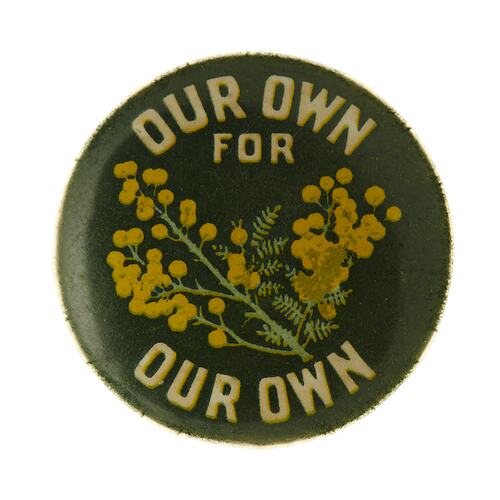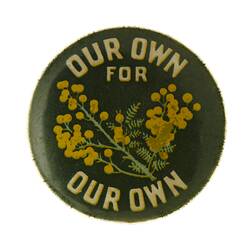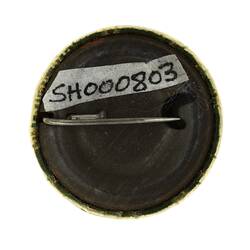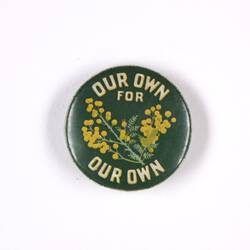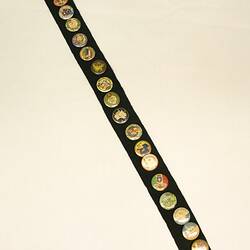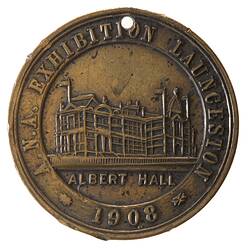Summary
Alternative Name(s): Button, Pin
Circular pressed tin Wattle Day fundraising badge - 'Our Own For Our Own'. Its design is identified by Pezikian & Anderson (2017:16) as issued for the September 1915 Wattle Day fundraising drive to raise money for children's charities. To support the event, trucks decorated with wattle blossoms paraded Melbourne's streets. The Age reported that over £2600 was raised (probably in Melbourne alone (3/9/1915, p.8).
One of 24 fundraising badges attached to a black velvet ribbon. Purchased and collected by the donor's great-grandmother, Mrs LIllie Mary Hollinger, in Melbourne (probably Canterbury).
Badges were worn or displayed on ribbons during and after World War I, commemorating involvement in the war effort and expressing patriotism. They were generally made to raise funds for particular causes, including comforts and medical aid for those serving overseas; assisting widows and children of deceased soldiers; and assisting with the purchase of aids and treatment for soldiers who returned with disabilities.
This badge features a wattle motif, and may have been produced for Wattle Day. The first 'national' Wattle Day was celebrated in Sydney, Melbourne and Adelaide on 1 September 1910. Wattle had become a symbol of Australia with the approach of Federation. It was particularly promoted by the Australian Natives' Association, established in Melbourne in 1871 as a non-partisan and non-sectarian friendly society for Australian-born, white men seeking to shape Australia's nationhood and identity. The ANA was a strong advocate for Federation and became an advocate for White Australia. It was a staunch supporter of trade protection and immigration restriction, and Prime Minister Alfred Deakin was a member. Public support for Wattle Day peaked during World War I, when it was a potent symbol of home for military personnel serving overseas, and a means of raising money for organisations such as the Red Cross. Beautifully designed Wattle Day badges as well as wattle sprigs were sold. The influence of Wattle Day waned as the 20th century progressed, but in 1992 the Governor-General declared 1 September National Wattle Day.
Physical Description
Circular pressed tin badge with dark green background, with inscription in white capitalised text. In the centre of the badge is an image of a sprig of yellow wattle. The back of the badge is a dull tin with minor rust. A bent nail has been utilised as the pin and is attached through a hole in the back of the badge.
More Information
-
Collecting Areas
-
Acquisition Information
Donation from Mrs Bronwyn Mitchell, 15 Feb 1994
-
Date Created
-
Organiser of Event
Australian Natives' Association (ANA)
Wattle Day was an initiative of the Australian Natives Association (ANA) and the Wattle Blossom League. -
Date of Event
-
Inscriptions
Text: 'OUR OWN / FOR / OUR OWN'.
-
Classification
-
Category
-
Discipline
-
Type of item
-
Overall Dimensions
2.2 cm (Width)
-
References
[Book] Pezikian, Nick & Andersen, David. 2017. Commonwealth Button Fund: WWI Patriotic & Fundraising Badges., 16 Pages
-
Keywords
Fundraising, Wars & Conflicts, World War I, 1914-1918, Wattle Day
